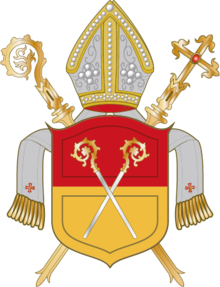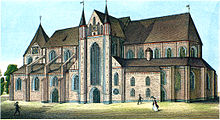
A | B | C | D | E | F | G | H | CH | I | J | K | L | M | N | O | P | Q | R | S | T | U | V | W | X | Y | Z | 0 | 1 | 2 | 3 | 4 | 5 | 6 | 7 | 8 | 9
This article has multiple issues. Please help improve it or discuss these issues on the talk page. (Learn how and when to remove these template messages)
|

The Diocese and Prince-bishopric of Schwerin was a Catholic diocese in Schwerin, Mecklenburg, in Germany. The first registered bishop was ordained in the diocese in 1053, and the diocese ceased to exist in 1994.
Pre-Reformation Catholic (prince-)bishopric
The bishops of the Roman Catholic diocese of Schwerin (German: Bistum Schwerin), a suffragan of the Metropolitan Archdiocese of Bremen, were simultaneously secular (political) rulers of princely rank (prince-bishop) in the Prince-Bishopric of Schwerin (Hochstift Schwerin); established 1180 and secularised in 1648), an imperially immediate state of the Holy Roman Empire. Schwerin was the seat of the chapter, Schwerin Cathedral and residence of the bishops until 1239. In 1180 a prince-episcopal residence was established in Bützow, which became the main residence in 1239.
Titulature of the Schwerin bishops
Not all incumbents of the Schwerin see were imperially invested with princely temporal power as Prince-Bishops and not all were papally confirmed as bishops. In 1180 part of the Schwerin diocesan territory was disentangled from the Duchy of Saxony and became an own territory of imperial immediacy called Prince-Bishopric of Schwerin, an imperially immediate feudal member state of the Holy Roman Empire like many prince-prelatures.


The prince-bishopric was an elective monarchy, with the ruling prince being the respective bishop usually elected by the Cathedral chapter, and confirmed by the Holy See, or exceptionally only appointed by the Holy See. Papally confirmed bishops were then invested by the emperor with the princely regalia, thus the title prince-bishop. However, sometimes the respective incumbent of the see never gained a papal confirmation, but was still invested the princely regalia. Also the opposite occurred with a papally confirmed bishop, never invested as prince. A number of incumbents, elected by the chapter, neither achieved papal confirmation nor imperial investiture, but as a matter of fact nevertheless de facto held the princely power. From 1532 to 1648 all incumbents were Lutherans.
The respective incumbents of the see bore the following titles:
- Bishop of Mecklenburg until 1162
- Bishop of Schwerin 1162 to 1181
- Prince-Bishop of Schwerin from 1181 to 1516, except o the years of 1474 to 1479 and 1506 to 1508
- Administrator of the Prince-Bishopric of Schwerin 1474 to 1479, 1506 to 1508, and again 1516 to 1648. Either simply de facto replacing the Prince-Bishop or lacking canon-law prerequisites the incumbent of the see would officially only hold the title administrator (but nevertheless colloquially referred to as Prince-Bishop).
Catholic bishops of Mecklenburg and Schwerin (1053–1181)
| Catholic Bishops of Mecklenburg and Schwerin (1053–1181) | |||||
| Episcopate | Portrait | Name | Birth and death with places |
Reason for end of office |
Notes |
|---|---|---|---|---|---|
| 1053–1066 | John Scotus as John I |
*approx. 990 – 10 November 1066* | death | martyr, sacrificed by pagans to Radegast | |
| 1066–1148 | sede vacante | the diocese was abandoned after the Wendish uprising | |||
| 1148–1162 | Eberhard also: Emmehard |
||||
| 1162–1191 | Berno of Amelungsborn[1] |
*unknown – 14 January 1191* | death | Apostle of the Obotrites, gained princely power in part of his diocese by 1181 on the carve-up of Saxony | |
Catholic Prince-Bishops (1181–1474)
| Roman Catholic Prince-Bishops of Schwerin (1181–1474) | |||||
| Reign and episcopate | Portrait | Name | Birth and death with places |
Reason for end of office |
Notes |
|---|---|---|---|---|---|
| 1162–1191 | Berno of Amelungsborn |
*unknown – 14 January 1191* | death | Apostle of the Obotrites, gained princely power in part of his diocese by 1181 on the carve-up of Saxony | |
| 1191–1238 | Brunward | ||||
| 1191–1195 | Hermann of Hagen |
anti-bishop | |||
| 1238–1240 | Frederick of Hagen as Frederick I |
||||
| 1240–1247 | Dietrich | ||||
| 1247–1249 | William | ||||
| 1249–1262 | Rudolph I | *unknown – 1262* | death | ||
| 1263–1291 | Hermann of Schladen as Hermann I |
||||
| 1292–1314 |  left image |
Godfrey von Bülow as Godfrey I (Bülow family) |
*unknown – 1314* | death | uncle of Henry I and Ludolph |
| 1315–1322 | Hermann von Maltzan as Hermann II |
||||
| 1322–1331 | Johann Gans zu Putlitz as John II (Gans zu Putlitz) |
||||
| 1331–1339 |  left image |
Ludolph von Bülow (Bülow family) |
*before 1298 – 23 April 1339*, Warin | death | nephew of Godfrey I, brother of the next, uncle of Frederick II |
| 1339–1347 |  right image |
Henry von Bülow as Henry I (Bülow family) |
*unknown – 1347* | death | brother of the former, nephew of Godfrey I, uncle of Frederick II |
| 1347–1348 | Willekin Pape | ||||
| 1348–1356 | Andrew of Wislica | ||||
| 1356–1363 | Albert of Sternberg German: Albrecht |
*c. 1333 – 14 January 1380*, Litomyšl | became Bishop of Litomyšl | also Bishop of Litomyšl (1364–1368, and again 1371–1380), Prince-Archbishop of Magdeburg (1368–1371) | |
| 1363–1365 | Rudolph of Anhalt as: Rudolph II (House of Ascania) |
*unknown – 1365*, Coswig in Anhalt | death | son of Albert II, Prince of Anhalt-Zerbst | |
| 1366–1377 |  right image |
Frederick von Bülow as: Frederick II (Bülow family) |
*unknown – 1366* | death | nephew of Ludolph and Henry I |
| 1377–1381 | Melchior of Brunswick and Lunenburg, Grubenhagen line (House of Welf) |
*1341 – 6 June 1384* | before Prince-Bishop of Osnabrück (1369–1375); rivalled in Schwerin by anti-bishop Marquard in 1377/1378 | ||
| 1377–1378 | Marquard Bermann | anti-bishop | |||
| 1381–1390 | John Potho of Pothenstein also: Pottenstein as John III |
*unknown – 1390* | death | before Prince-Bishop of Münster (1379–1382) appointed only, de facto he could not prevail over his rivals in Schwerin | |
| 1381–1388 | Johann Junge as John IV |
anti-bishop | |||
| 1381–? | Gerard of Hoya (Counts of Hoya) |
anti-bishop | |||
| 1390–1415 | Rudolf of Mecklenburg-Stargard as: Rudolph III (House of Nikloting) |
*unknown – 1415* | death | before Bishop of Skara (1387–1391), son of John I, Duke of Mecklenburg-Stargard | |
| 1416–1418 | Henry of Nauen as Henry II |
||||
| 1419–1429 | 
|
Henry of Wangelin as Henry III |
|||
| 1429–1444 | Hermann Köppen as Hermann III |
*unknown – 3 January 1444* | death | ||
| 1444–1457 | Nicholas Bödeker as Nicholas I |
||||
| 1458 | Godfrey Lange as Godfrey II |
||||
| 1458–1473 | Werner Wolmers |
||||
Catholic Administrators and Prince-bishops (1474–1532)
| Catholic Administrators and Prince-Bishops (1474–1532) | |||||
| Reign and episcopate | Portrait | Name | Birth and death with places |
Reason for end of office |
Notes |
|---|---|---|---|---|---|
| 1474–1479 | Balthasar of Mecklenburg (House of Nikloting) |
*1451 – 16 March 1507*, Wismar | resigned tired from pursuing investiture, turned secular | before Administrator of the Prince-Bishopric of Hildesheim (1471–1474); only administrator, never invested bishop; since duke in Mecklenburg-Schwerin, co-ruling with his brother Magnus II | |
| 1479–1482 | Nicholas of Pentz as Nicholas II |
||||
| 1482–1503 | 
|
Conrad Loste |
|||
| 1504–1506 | John Thun as John V |
||||
| 1504 | Reimar von Hahn (Hahn family) |
anti-bishop | |||
| 1506–1508 | Ulrich von Malchow | only administrator, never invested as bishop | |||
| 1508–1516 | Petrus Wolkow |
||||
| 1516–1522 | Zutpheld Wardenberg |
only administrator for the minor Magnus, also Dean (Domdechant) of Schwerin Cathedral | |||
| 1522–1532 | Heinrich Banzkow also: Banzcow or Bantzkow |
*before 1499–1540* | resigned when Magnus came of age | only administrator for the minor Magnus, never pursued investiture as bishop; also provost of Hamburg Cathedral | |
Due to the Reformation, the Catholic diocese was suppressed in 1555, without formal successor.
Lutheran Schwerin
Lutheran Administrators of the Prince-Bishopric (1532–1648)
| Lutheran Administrators of the Prince-Bishopric (1532–1648) | |||||
| Reign and episcopate | Portrait | Name | Birth and death with places |
Reason for end of office |
Notes |
|---|---|---|---|---|---|
| 1532–1550 | Magnus of Mecklenburg (House of Nikloting) |
Stargard, *4 July 1509 – 28 January 1550*, Bützow | death | bishop elect since 1516, due to minority only officiating since 1532 as administrator, due to lack of papal confirmation, Magnus introduced the Reformation in 1533 | |
| 1550–1603 | 
|
Ulrich of Mecklenburg as Ulrich I (House of Nikloting) |
Schwerin, *5 March 1527 – 14 March 1603*, Güstrow | death | grandfather of the next; also Duke of Mecklenburg-Güstrow (1555–1603) |
| 1603–1624 | Ulrik of Denmark as Ulrich II (House of Oldenburg) |
Koldinghus Palace, Kolding, *30 December 1578 – 27 March 1624*, Rühn | death | grandson of the former, uncle of the next; also Lutheran Bishop of Schleswig (1602–1624) | |
| 1624–1629 | 
|
Ulrik of Denmark as Ulrich III (House of Oldenburg) |
Frederiksborg Palace, Hillerød, *2 February 1611 - 12 August 1633*, Schweidnitz | resigned when his father Christian IV renounced posts held by his family in the Empire in 1629 (Treaty of Lübeck)
Zdroj:https://en.wikipedia.org?pojem=Diocese_and_prince-bishopric_of_Schwerin Text je dostupný za podmienok Creative Commons Attribution/Share-Alike License 3.0 Unported; prípadne za ďalších podmienok. Podrobnejšie informácie nájdete na stránke Podmienky použitia.
Analytika
Antropológia Aplikované vedy Bibliometria Dejiny vedy Encyklopédie Filozofia vedy Forenzné vedy Humanitné vedy Knižničná veda Kryogenika Kryptológia Kulturológia Literárna veda Medzidisciplinárne oblasti Metódy kvantitatívnej analýzy Metavedy Metodika Text je dostupný za podmienok Creative
Commons Attribution/Share-Alike License 3.0 Unported; prípadne za ďalších
podmienok. www.astronomia.sk | www.biologia.sk | www.botanika.sk | www.dejiny.sk | www.economy.sk | www.elektrotechnika.sk | www.estetika.sk | www.farmakologia.sk | www.filozofia.sk | Fyzika | www.futurologia.sk | www.genetika.sk | www.chemia.sk | www.lingvistika.sk | www.politologia.sk | www.psychologia.sk | www.sexuologia.sk | www.sociologia.sk | www.veda.sk I www.zoologia.sk | |
